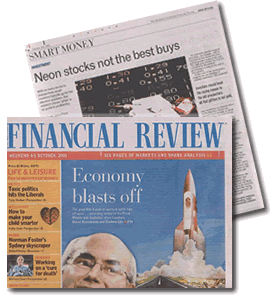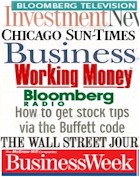If you are not using selection
software such as Conscious Investor when choosing stocks
you are losing money. This is the conclusion of recent research
described in the following article that appeared in the
Smart Money section of "The Australian Financial Review"
(October 4-5, 2003).
"Glitter" stocks are those stocks
that are attention-grabbing for reasons such as they had
high trading volume, there were extreme movements in the
price whether up or down, or the stocks were in the news.
Research shows that individual investors tend to buy these
stocks. The same research shows that, unfortunately, such
stocks underperform the market on average.
This is just another reason for having
screening software such as Conscious Investor so that you
can instantly run through thousands of stocks looking for
quality investments. Without it most people end up with
glitter stocks. And we know what the old prospectors used
to say, "all that glitters is not gold."

How do Mr. and Mrs. Average Investor choose
their stocks? Careful analysis of reports from stockbrokers?
No time. Interviewing members of the board and senior management
of the company? It is unlikely their calls would be returned.
How about looking at stocks with extreme price changes?
Now you are getting closer. If you also added the “glitter”
stocks that are in the news or have abnormally high trading
volume you would have the bases well covered.
Recent research by Brad Barber and Terrence
Odean of the University of California shows that individual
investors tend to purchase stocks on the days after there
is some sort of attention-grabbing activity. Specifically,
they tend to purchase stocks on the days after there was
high trading volume, when there were extreme movements in
the price whether up or down, and when the stocks were in
the news.
Earlier studies by Barber and Odean showed
that investors were systematically reluctant to sell their
stocks for a loss. We hate to have to admit that we have
made a mistake. So we hang on to losers even though from
a tax perspective it is better to declare our losses as
soon as possible. Even more significant is the fact that
by hanging on to their losers, investors were hurting their
overall performance.
In this recent study the authors set out to
look at the other side. Why do investors choose to buy particular
stocks? This is a formidable problem for investors. In the
USA there are over 10,000 stocks to choose from. In Australia,
over 1,500.
They looked at the trading accounts of over
700,000 individual investors and 43 professional money managers.
The results show that there is a difference between methods
used by individual investors and professional investors.
It seems that professional investors are less likely to
invest in attention-grabbing stocks. Possibly this is because
they have more time and resources, including computer programs
such as Conscious Investor, for monitoring a larger range
of companies.
In contrast, individual investors with limited
resources are more likely to purchase stocks that capture
their attention in the ways mentioned above such as stocks
that are in the news.
Of course, there is nothing wrong with this
approach if their choices turn out to be profitable. Alas,
on average this does not turn out to be the case. Consider
momentum investors who believe that if a stock rises in
price, it is likely to keep rising. The researchers found
that more people bought a stock when there was an abnormally
high return on the previous day. Yet this resulted in underperformance
over the next month against the stocks that were sold and
against the overall market.
A similar result held for contrarian investors
who believe that if there is an abnormal dip in price, then
there will be a profitable rebound. Once again the outcome
was underperformance over the following month.
You can see the details in the following chart
for the four attention-grabbing categories: high volume,
abnormally high return, abnormally low return and news releases.
BETTING
ON THE WRONG HORSE |
Underperformance
Over the Following Year |
| Share Category |
High Volume |
High Return |
Low Return |
News |
| Underperformance |
-4.27% |
-6.10% |
-7.77% |
-2.82% |
| Source: Brad Barber and Terrance Odean.
We assume the strategy is rolled over each month. |
When these results are looked at in the context
of research by Daniel Kahneman, the 2002 Nobel Prize winner
in economic sciences, we shouldn’t be surprised. Kahneman
showed that we make evaluations of an extended experience
based on the most extreme component of the experience and
by the most recent component. Everything else is given less
importance. He refers to it as the peak/end rule.
An extremely painful surgical procedure will
be reported as less severe if a less painful period is added
at the end. The painful period can even be extended by the
medical practitioner so long as the end is less painful.
In the case of the stock market, suppose we
are thinking of making a purchase. The peak/end rule would
bias us towards those stocks that have drawn our attention
most strongly or about which we have the most recent news.
And if these happen to be the same event such as recent
high volume, then the relevant stock will be even more dominant
in our mind as a stock to buy.
Not everyone believes that investors can be
so easily influenced or that share prices are so rubbery.
One of these is Myron Scholes, the Nobel Prize-winning economist,
a supporter of the school that teaches that the share price
always describes the true value of the company.
When he expressed this opinion to Bill George,
the former CEO of the billion dollar company Medtronic,
George replied, “Myron, I sit in the CEO’s chair,
and I can tell you how easy it is to raise our stock price
in the short term… We can go out and hype the stock.”
The story goes that Scholes flung his pencil down on the
table.
The point is that whatever the short-term
effect, Barber and Odean’s research shows that any
resulting price rises are not likely to stay for long. All
in all, investors would be well to take heed of the saying
known to the old prospectors—all that glitters is
not gold.
Disclaimer
Conscious Investing provides general advice
and information, not individually targeted personalised
advice. Advice from Conscious Investing does not take into
account any investor’s particular investment objectives,
financial situation and personal needs. Investors should
assess for themselves whether the advice is appropriate
to their individual investment objectives, financial situation
and particular needs before making any investment decision
on the basis of such general advice. Investors can make
their own assessment of the advice or seek the assistance
of a professional adviser.
Investing entails some degree of risk. Investors
should inform themselves of the risks involved before engaging
in any investment.
Conscious Investing endeavours to ensure accuracy
and reliability of the information provided but does not
accept any liability whatsoever, whether in tort or contract
or otherwise, for any loss or damage arising from the use
of Conscious Investing data and systems. Past performance
is not necessarily indicative of future results. Information
and advice provided here is not an offer to buy or sell
securities. View
the full Disclaimer. |




